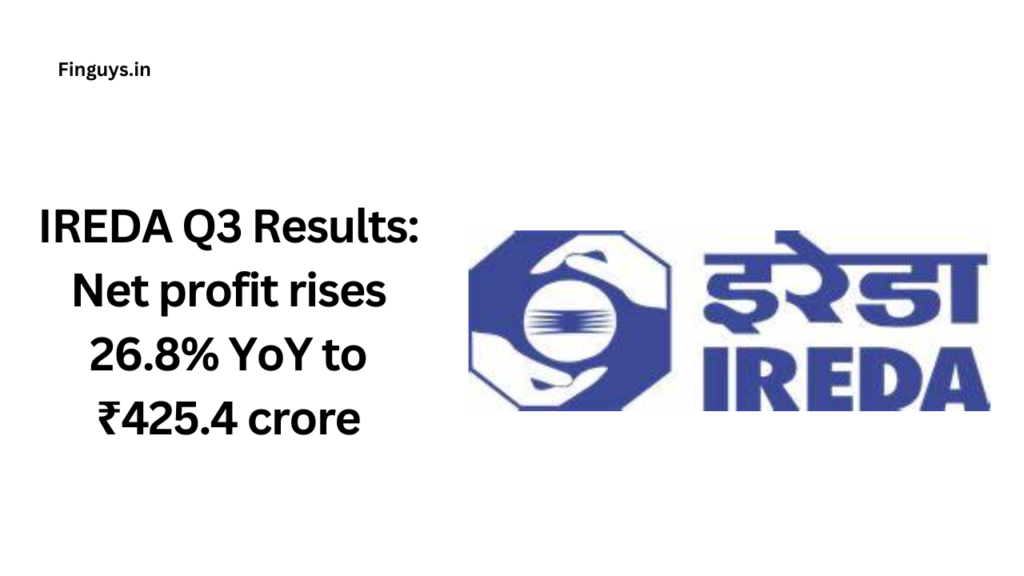The Indian Renewable Energy Development Agency (IREDA) has posted remarkable Q3FY25 financial results, showcasing robust growth across key performance metrics. With a 27% year-on-year (YoY) increase in Profit After Tax (PAT) to ₹425.38 crore and a 35.6% rise in total revenue from operations to ₹1,698.45 crore, IREDA’s latest quarterly performance underscores its strong financial health and strategic progress. This article delves into the specifics of IREDA’s Q3FY25 results and their implications for stakeholders.

Key Highlights of IREDA Q3FY25 Results
- Profit After Tax (PAT):
- YoY Growth: PAT surged by 27%, reaching ₹425.38 crore compared to ₹335.53 crore in Q3FY24.
- Sequential Growth: On a quarter-over-quarter (QoQ) basis, PAT rose by 10% from ₹387.75 crore in Q2FY25.
- Revenue from Operations:
- Total revenue increased to ₹1,698.45 crore, up 35.6% YoY from ₹1,252.85 crore in Q3FY24.
- Net Interest Income (NII):
- NII grew by 39% YoY to ₹622.3 crore, compared to ₹448.1 crore in the previous year’s quarter.
- Operating Profit:
- Operating profit before depreciation, impairment, and tax increased by 51% YoY to ₹652 crore.
- Expenses:
- Total expenses rose to ₹1,160.78 crore, marking a YoY increase but a QoQ decline from ₹1,170.48 crore in Q2FY25.
Revenue Breakdown and Growth Drivers
| Metric | Q3FY25 | Q2FY25 | Q3FY24 | YoY Growth |
|---|---|---|---|---|
| Total Revenue (₹ crore) | 1,698.45 | 1,577.05 | 1,252.85 | 35.6% |
| Interest Income (₹ crore) | 1,654.45 | 1,577.05 | 1,208.10 | 36.9% |
| Fees & Commission (₹ crore) | 16.46 | 25.64 | 19.88 | -17.2% |
The primary growth driver was the surge in interest income, which constituted the lion’s share of the total revenue. Despite a marginal decline in fees and commission income, the overall revenue trajectory remained upward, reflecting IREDA’s strategic focus on its core lending operations.
Debt and Loan Portfolio Analysis
IREDA’s debt-to-equity ratio rose to 5.89 as of December 31, 2024, compared to 5.13 a year earlier. This uptick reflects the company’s increased borrowing to fund its growing loan portfolio.
| Metric | Q3FY25 | Q3FY24 | YoY Growth |
|---|---|---|---|
| Outstanding Loan Book (₹ crore) | 68,960 | 50,580 | 36% |
The 36% YoY increase in the outstanding loan book highlights IREDA’s expanding footprint in renewable energy financing, aligned with India’s push for green energy projects.
Expense Trends and Efficiency
Total expenses rose by 33.9% YoY to ₹1,160.78 crore. The major expense components included:
- Finance costs
- Employee benefits
- Corporate Social Responsibility (CSR) initiatives
Despite the increase, the expense-to-revenue ratio has improved due to higher revenue growth, reflecting operational efficiency.
Comparative Analysis: 9MFY25 Performance
For the nine months ending December 31, 2024, IREDA reported robust financials:
| Metric | 9MFY25 | 9MFY24 | YoY Growth |
|---|---|---|---|
| Total Revenue (₹ crore) | 4,714.25 | 3,493.79 | 35% |
| PAT (₹ crore) | 1,196.81 | 914.85 | 31% |
These figures reinforce IREDA’s consistent growth trajectory over the fiscal year, driven by strategic lending initiatives and enhanced interest income.
Implications for Investors
IREDA’s Q3FY25 performance reflects its pivotal role in financing renewable energy projects in India. Key takeaways for investors include:
- Strong Financial Position:
- Consistent PAT growth and expanding revenue base signal robust financial health.
- Renewable Energy Focus:
- As India’s renewable energy sector grows, IREDA’s loan book expansion positions it as a key beneficiary.
- Operational Efficiency:
- Improved expense management enhances profitability.
- Risk Management:
- A higher debt-to-equity ratio may signal increased leverage risk, necessitating close monitoring.
Conclusion
IREDA’s Q3FY25 results highlight its solid financial performance, driven by strong interest income growth and strategic lending. With a 36% YoY increase in its loan book and a 27% PAT rise, IREDA is well-poised to capitalize on India’s renewable energy ambitions. However, investors should keep an eye on the rising debt levels and broader economic conditions impacting the renewable energy sector.
Disclaimer: The information provided in this article is for informational purposes only and should not be considered financial advice. Readers are encouraged to conduct their own research or consult a financial advisor before making investment decisions.